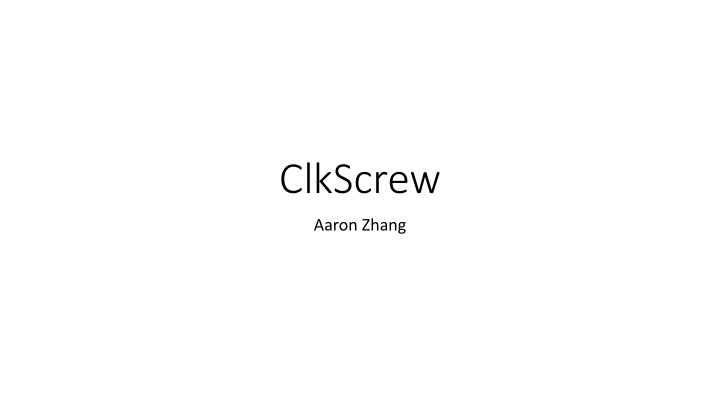



ClkScrew Aaron Zhang
Outline • Introduction to DVFS and background information. • What makes CLKSCREW unique? • Challenges to CLKSCREW • Attacks and Results • Conclusion
Voltage Energy + = Usage Frequency
HARDWARE DVFS (Dynamic Voltage and Frequency Scaling) SOFTWARE
Outline • Introduction to DVFS and background information. • What makes CLKSCREW unique? • Challenges to CLKSCREW • Attacks and Results • Conclusion
1 1 1 FLIP FLOP FLIP FLOP
Less time for number to go through Flip-Flop 0 0 1 FLIP FLOP FLIP FLOP
NON- TRUSTZONE TRUSTZONE DVFS
Steps 1. Clear Residual States 2. Profile for Anchor 3. Pre-fault Delaying 4. Deliver the fault.
Outline • Introduction to DVFS and background information. • What makes CLKSCREW unique? • Challenges to CLKSCREW • Attacks and Results • Conclusion
Do phones allow for overclocking/ under-volting?
How do you make sure the flip-flops do not damage the injected code?
Attacker Code CPU CORE 1 Victim Thread CPU CORE 2
How do you get the timing precise enough? How do we make sure the attack occurs where we want it to occur?
Outline • Introduction to DVFS and background information. • What makes CLKSCREW unique? • Challenges to CLKSCREW • Attacks and Results • Conclusion
Inferring AES Keys AES Attacking Decryption Code NON- TRUSTZONE TRUSTZONE DVFS
Loading Apps into Trust Zone Attacker’s Attacking App Code NON- TRUSTZONE TRUSTZONE DVFS
• Each App has 4 Signatures • One signature takes 270 Million clock cycles to App validate. 1. Signature 1 2. Signature 2 • In order for CLKSCREW to 3. Signature 3 4. Signature 4 corrupt data it needs to change just 65 thousand clock cycles within the entire process
65000/1080000000 = 0.0000601%
Cache Profiling • Pick a memory address of the area of interest • Run dummy instructions and time the amount it takes for these instructions to be removed • Patterns for removing will tell you the pattern of the actual code. Timing Anchor • Track duration of consecutive cache instructions
One instance of Desired Fault out of 65
Outline • Introduction to DVFS and background information. • What makes CLKSCREW unique? • Challenges to CLKSCREW • Attacks and Results • Conclusion
Defenses
Hardware Limits regarding Voltage and Frequency • Make it unable for users to overclock and under- volt their phones • Difficulties include having to remake hardware chips from scratch and having every phone and chipmaker adhere to regulation.
Separate DVFS for Trustzone • Create a separate DVFS for Trustzone itself • Separate DVFS’ for cores on the same chip can cause massive overhead.
Randomization • Randomize clock cycles so that attackers do not know what to expect. • Useless when run-time time-anchors are used.
Conclusions • CLKSCREW is a side-channel attack that utilizes voltage and frequency of devices to induce faults. • Exploiting faults that cannot be easily changed.
Recommend
More recommend